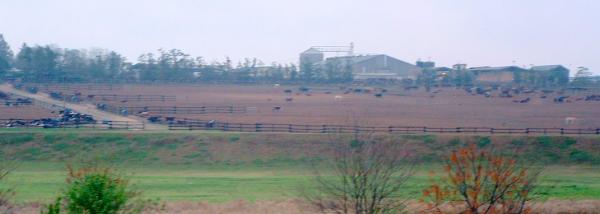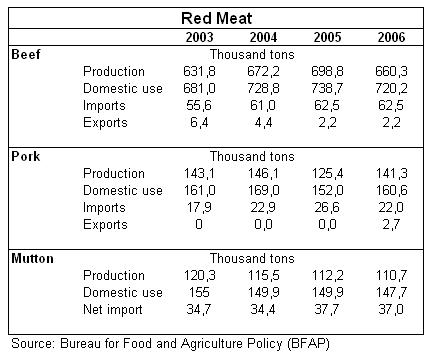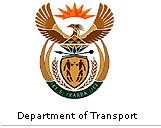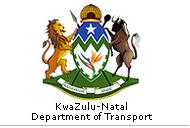 |
Meat Processing and DistributionThe consumption of chicken meat is on the increase in
South Africa and is bigger than the total consumption of
red meat; a trend that is likely to continue. [Broiler
poultry production is discussed elsewhere in this Freight
Transport Databank, under the Poultry industry].
The red meat industry remains one of the most important
agricultural sub-sectors in South Africa, but has come
under increasing pressure in the period following
deregulation. This is mainly due to;
(i) declining per capita demand for red meat,
(ii) increased competition from overseas producers,
Southern African Development Community (SADC)countries,
Namibia and Botswana, and
(iii) institutional challenges.
Almost 60% of cattle in South Africa are finished for
slaughter in feedlots (confined areas with watering and
feeding facilities where livestock are fed grains and
concentrates to produce consistent meat quality). The other
40% of beef cattle are raised on natural grassland.
Some of the largest feedlots in KZN are situated in the
Cato Ridge, Cramond and Vryheid areas. South African
feedlots normally buy weaner calves with a live mass of
230 kg at an age of 205 days, and add 105 kg carcass mass
through extensive feeding for about 100 days, eventually
slaughtering an animal at approximately 215 kg carcass
weight. The weights vary according the age and breed of
cattle. When animals are ready for the market, they are
transported from the farm or feedlots to the abattoir by
road. The transportation of live cattle is governed by the
transportation welfare codes, known as LWCC (Livestock
Welfare Coordinating Committee).

Feedlot
|
The abattoir is a key transformation area in the South
African meat supply chain. The abattoir industry is
responsible for the conversion of livestock to meat or
carcasses. Processing plants or meat manufacturers consist
generally of two types of production cycles - the canned
meat and/or the fresh meat cycle. The cuts have to be under
constant cooling, and therefore the loading takes place in
an area that is totally sealed off to ensure the products
do not come in contact with hot air. All frozen products
are kept at a temperature of -18ºC”. If the cold
chain is interrupted, the shelf live of products is
significantly reduced. Below is a diagram illustrating the
red meat industry.
The livestock population in KwaZulu-Natal at the end of
2005 was as follows:
cattle 2,857,000, sheep 775,000 and pigs 164,000. In KwaZulu-Natal, the number of registered abattoirs
stands at approximately 49 (see table below), which
constitutes approximately 10% of all those in South Africa.
Following the recent deregulation of the South African
meat industry, a number of the larger feedlots have now
vertically integrated into processing, wholesaling and
even retailing their own quality beef products. The grades
of abattoirs varies from an A grade where over 100 cattle
are slaughtered a day to grade F, where fewer that 4 cattle
per day are slaughtered.

|
South Africa, as is evident from the table above,
consumes more than it produces. In 2006 South Africa
produced 660,300 tons of beef of which 720,200 tons were
consumed; pork production was 141,300 tons of which 160,600
tons were consumed, mutton production was 110,700 tons of
which 147,700 tons were consumed.
South Africa is an importer of beef (62,500 tons),
mutton (37,000 tons) and pork (22,000 tons) as indicated in
the table. Beef is mainly imported from SACU countries
(Namibia,
Botswana, Swaziland and Lesotho) and also from Argentina,
Paraguay, Australia, Zimbabwe, Brazil, Uruguay and New
Zealand.
South Africa is a net importer of lower
grade meat, mostly for the processing sector, while it
exports some higher grade cuts to specific niche’
world
markets to realise above-average rate of returns.
South Africa exported 2,200 tons of beef mainly to Angola,
Germany, Great Britain, Greece, Lebanon, Mozambique,
Norway, Reunion and Swaziland. One of the large abattoirs situated in Ladysmith produces
approximately 65,000 tons of red meat, which is
distributed predominantly in Northern KwaZulu-Natal. The
cattle and sheep are transported by road from areas in the
Free State such as Harrismith, Bethlehem and Vrede to the
abattoir. Approximately 4,500 tons of mutton is produced
in KwaZulu-Natal, which indicates that it is not self
sufficient to meet its domestic demand, therefore 37,000
tons of mutton is imported from the rest of the world
through Durban harbour to meet the demand in KwaZulu-
Natal, Mpumalanga and Gauteng.
KwaZulu-Natal, Limpopo and Gauteng are self-sufficient in
the production of pork. Excess production in KwaZulu-Natal
is supplied to the Northern Cape, Free State and
Mpumalanga. Imports entering through the port of Durban
are supplied to Mpumalanga. Transport in the meat industryTransport in the meat industry is entirely by
road, using vehicles of appropriate configurations for the
cargo carried. Cattle are transported in open carriers,
pigs tend be transported on flat-bed, gate-sided,
open vehicles, and sheep are transported in purpose-made,
triple-deck, livestock carriers. When livestock are ready
for the market, the animals are transported from the
producer (farmer) or feedlots to the abattoir. Once
slaughtered, meat is stored in refrigerated cold stores
and the carcasses are transported from the abattoir in
refrigerated vehicles for distribution to
butcheries, wholesalers and retailers, and by direct
delivery to hotels, restaurants and other hospitality
establishments.
Based on the production figures for cattle, an estimated
2,4 million cattle 5,2 million sheep and 2 million
pigs were transported to various abattoirs in South Africa
to be slaughtered, which amounts to in excess of 900,000
tons on the road network. If one includes the imports of
beef, mutton and pork, approximately 1 million tons of red
meat is being transported to various markets within South
Africa.
The supermarkets also play an important role in the
distribution of beef products to the countrywide consumer
market. Although insulated, the vehicles used are not
permitted to travel on gravel roads for fear of
contaminating the product, which will amount to huge
losses.
|
 |



